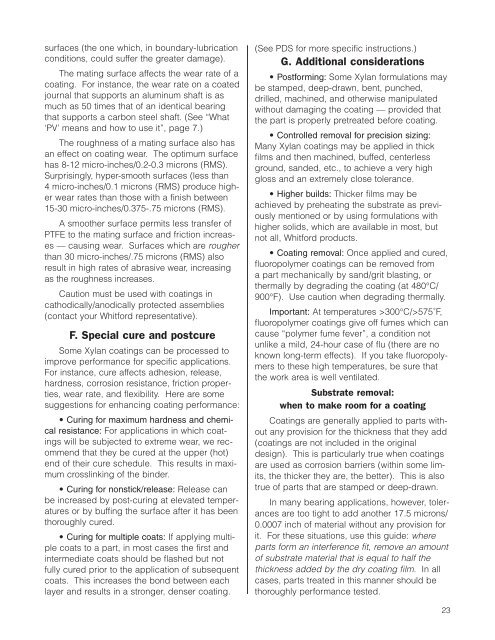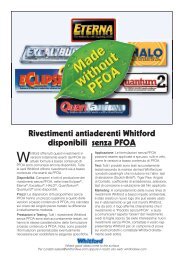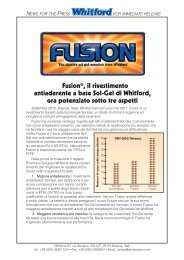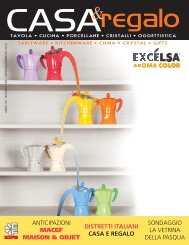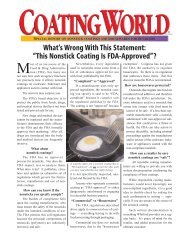Literature PDF
Literature PDF
Literature PDF
- No tags were found...
Create successful ePaper yourself
Turn your PDF publications into a flip-book with our unique Google optimized e-Paper software.
surfaces (the one which, in boundary-lubricationconditions, could suffer the greater damage).The mating surface affects the wear rate of acoating. For instance, the wear rate on a coatedjournal that supports an aluminum shaft is asmuch as 50 times that of an identical bearingthat supports a carbon steel shaft. (See “What‘PV’ means and how to use it”, page 7.)The roughness of a mating surface also hasan effect on coating wear. The optimum surfacehas 8-12 micro-inches/0.2-0.3 microns (RMS).Surprisingly, hyper-smooth surfaces (less than4 micro-inches/0.1 microns (RMS) produce higherwear rates than those with a finish between15-30 micro-inches/0.375-.75 microns (RMS).A smoother surface permits less transfer ofPTFE to the mating surface and friction increases— causing wear. Surfaces which are rougherthan 30 micro-inches/.75 microns (RMS) alsoresult in high rates of abrasive wear, increasingas the roughness increases.Caution must be used with coatings incathodically/anodically protected assemblies(contact your Whitford representative).F. Special cure and postcureSome Xylan coatings can be processed toimprove performance for specific applications.For instance, cure affects adhesion, release,hardness, corrosion resistance, friction properties,wear rate, and flexibility. Here are somesuggestions for enhancing coating performance:• Curing for maximum hardness and chemicalresistance: For applications in which coatingswill be subjected to extreme wear, we recommendthat they be cured at the upper (hot)end of their cure schedule. This results in maximumcrosslinking of the binder.• Curing for nonstick/release: Release canbe increased by post-curing at elevated temperaturesor by buffing the surface after it has beenthoroughly cured.• Curing for multiple coats: If applying multiplecoats to a part, in most cases the first andintermediate coats should be flashed but notfully cured prior to the application of subsequentcoats. This increases the bond between eachlayer and results in a stronger, denser coating.(See PDS for more specific instructions.)G. Additional considerations• Postforming: Some Xylan formulations maybe stamped, deep-drawn, bent, punched,drilled, machined, and otherwise manipulatedwithout damaging the coating — provided thatthe part is properly pretreated before coating.• Controlled removal for precision sizing:Many Xylan coatings may be applied in thickfilms and then machined, buffed, centerlessground, sanded, etc., to achieve a very highgloss and an extremely close tolerance.• Higher builds: Thicker films may beachieved by preheating the substrate as previouslymentioned or by using formulations withhigher solids, which are available in most, butnot all, Whitford products.• Coating removal: Once applied and cured,fluoropolymer coatings can be removed froma part mechanically by sand/grit blasting, orthermally by degrading the coating (at 480°C/900°F). Use caution when degrading thermally.Important: At temperatures >300°C/>575˚F,fluoropolymer coatings give off fumes which cancause “polymer fume fever”, a condition notunlike a mild, 24-hour case of flu (there are noknown long-term effects). If you take fluoropolymersto these high temperatures, be sure thatthe work area is well ventilated.Substrate removal:when to make room for a coatingCoatings are generally applied to parts withoutany provision for the thickness that they add(coatings are not included in the originaldesign). This is particularly true when coatingsare used as corrosion barriers (within some limits,the thicker they are, the better). This is alsotrue of parts that are stamped or deep-drawn.In many bearing applications, however, tolerancesare too tight to add another 17.5 microns/0.0007 inch of material without any provision forit. For these situations, use this guide: whereparts form an interference fit, remove an amountof substrate material that is equal to half thethickness added by the dry coating film. In allcases, parts treated in this manner should bethoroughly performance tested.23


